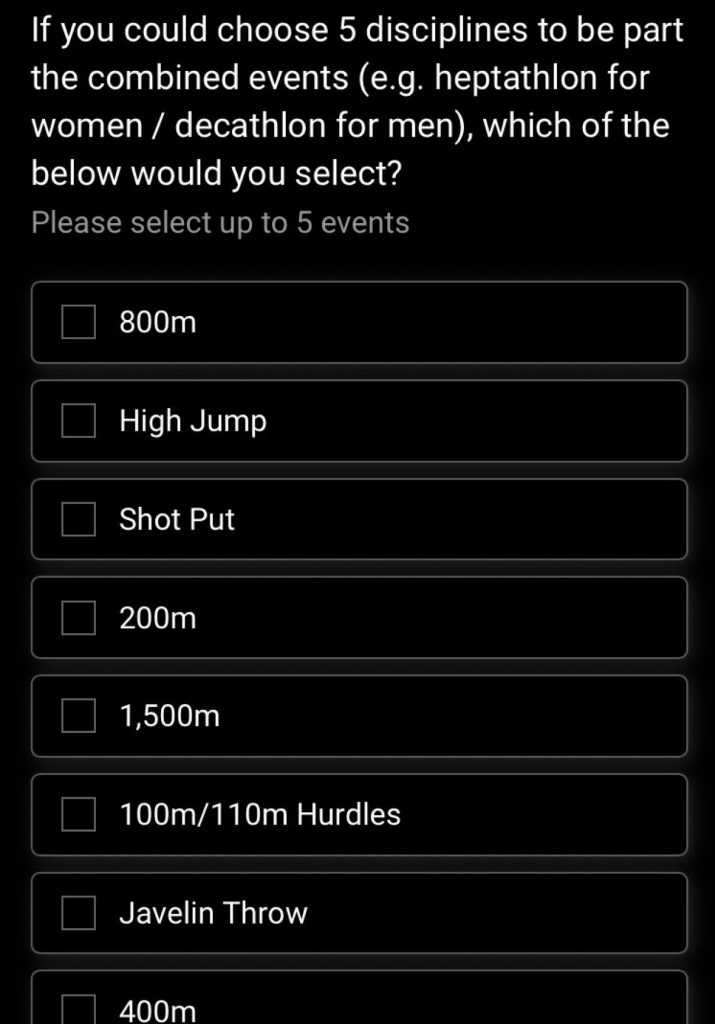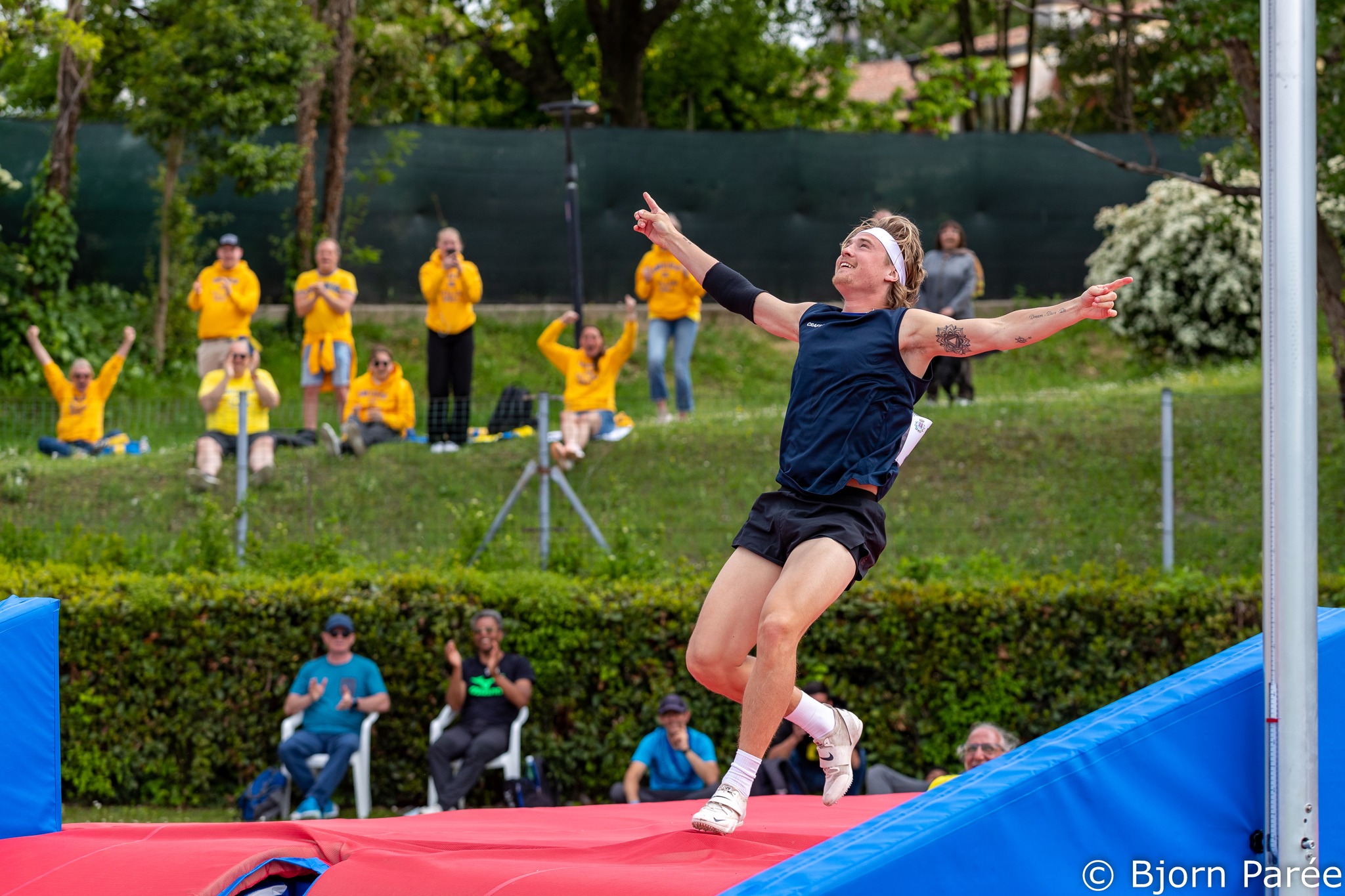Over two years after Fredrik Samuelsson first wrote to World Athletics, there is finally some cause for hope on combined events field sizes at world indoor and world outdoor championships. But with that positive news comes some questions, after World Athletics quiz fans at Budapest “if you could choose 5 disciplines to be part of the combined events…which would you select?”
FIELD SIZES
The most recent development on field sizes emerged over the summer when Fredrik had the opportunity to convey the combined events community’s concerns directly to the World Athletics (WA) Competition Commission. The Competition Commission is the forum within WA with responsibility for providing advice on the format, qualifications, programme and organisation of international competition. The opportunity to present was facilitated by the WA Athletes’ Commission.
The Commission were sympathetic to the principle of reversing the direction of travel in field sizes for combined events but cited concerns about the impact on the schedule. They favoured an incremental approach, mirroring that taken by European Athletics at the European Indoor Championships in Istanbul this year: increasing the field by a small number and testing for adverse impact before increasing further.
At the meeting of the WA Council in Budapest, the Council therefore considered, and approved, a proposition from the Commission to increase the number of combined events athletes from 12 to 14 for the 2025 World Indoor Athletics Championships in Nanjing, and to review the qualification for the competition to maximise the opportunity for athletes competing in the current indoor season to qualify.
The field size for World Indoors is actually the only one which has not reduced in recent years, because it was previously even worse – a mere eight until Portland in 2016.
At present, qualification for the World Indoors allows only five places for athletes to qualify via the current indoor season. Five places are filled from the world lists in the previous outdoor season, one place is reserved for the winner of the previous year’s combined events tour, one place is at the discretion of World Athletics, and the remaining five places are drawn from the current indoor season world lists.
In practice, more than five places may be filled by athletes competing in the current indoor season, but those places often only become available at the last minute when athletes have ended their season on the assumption that they have not qualified. Similarly, many athletes may design their season on the assumption they will not qualify into the five places available, and then be unable to compete if a place becomes available at short notice.
Frustratingly, this current arrangement can result in difficulties in filling fields. That can perversely lead to governing bodies and federations criticising athletes for not competing. Furthermore the rationale is then used as a reason not to increase field sizes, despite arising as a consequence of the qualifying conditions created by the governing body.
Implementation of the new approach will be taken forward by the refreshed WA structures following elections in the summer.
Commenting on his experience talking to World Athletics, Fredrik Samuelsson said:
“I really appreciated the opportunity to speak to the commission, and explain the concerns of all the combined events community. It was good to hear that WA were open to increasing field sizes, and while our aim is to have 16/32, an increase to 14 in Nanjing is a small step to add to 14 in Istanbul. This is really important to us because it may both make older people to extend their careers, but also the younger ones to keep dreaming and aiming for a spot. With more spots, we will be seen and inspire more. Now the next target is to push on an increase for Tokyo 2025 and forwards.“
WHY DID FIELD SIZES REDUCE IN THE FIRST PLACE?
During Fredrik’s discussion with WA, it transpired that one of the drivers to reduce field sizes at international championships was the heptathlon pole vault at the European Indoors Championships in Belgrade in 2017. The concern was that it ran on and delayed other events, pushing them out of the window for the TV schedule.
What’s interesting about this rationale, however, is the context. The idea of a combined event pole vault competition hogging prime time broadcast space is laughable – the combined events are fortunate if anyone beyond the leaders and the home athletes get any airtime at all in the field events.
But in Serbia in 2017 it was a little different. The home country’s top decathlete, Mihail Dudas, was competing and in contention for a medal. Dudas was among the top pole vaulters, and cleared a PB of 5.10m behind Kevin Mayer and Belgium’s Niels Pittomvils, who both cleared 5.40m.
The European Athletics report from the event begins with a reflection on Mayer’s European Record. It goes on to say:
“But the main drama of this concluding event involved Serbia’s Mihail Dudas, who started the 1000m just one place and 52 points off a medal place, but who seemed on the brink of adding a home bronze to the gold already secured by Ivana Spanovic as he responded to the thunderous support in the packed Kombank Arena”.
So, if the broadcast stayed with the home medal hope who was competing out of his skin, and staying with the world class vaulters in the field, that was a decision made by the host broadcaster. It is certainly not the general experience that combined events coverage is prioritised over other events, and as a rationale for cutting field sizes across all major championships, it is not a robust one.
But if World Athletics follow through on their commitment, we should see 14 athletes at the World Indoors in Nanjing in 2025 as the first step in an increase in field sizes at global championships.
Fredrik summarised further: “It was helpful to hear from WA some of the reasons for the reductions in field sizes, such as the pole vault in Belgrade 2017, because it gives us an opportunity to clarify some misunderstandings and ensure we are all working together to promote the world’s greatest athletes, and create opportunities for the next generation to come through. And not only come through, but that they also feel it’s worth staying in it for long, because bigger fields keep athletes pushing and striving for the Championships. Fewer spots keep closing doors and hopes for not only the athletes, but the sport itself.”
While the progress is welcome, it is painfully slow. If the lead in time for change is two years, and it takes two years to even get a conversation with World Athletics, significant chunks of athletes’ careers are passing by. Every year, another eight athletes are missing the opportunity to compete at a major outdoor championships because, it seems, of a misunderstanding about the pole vault in Belgrade.
The next steps will be to follow up with World Athletics once the new structure is settled in, with an eye to informing a provisional increase for the World Championships in Tokyo in 2025; and to return to European Athletics to confirm next steps following the increase of 14 at the European Indoors in Istanbul, in particular an increase for the outdoor European Championships in Birmingham 2026.
“CHOOSE FIVE DISCIPLINES”
Meanwhile, in the days following the World Championships in Budapest, athletics fans received the usual follow-up correspondence about their experience of the champs. However, one of the questions in the survey raised some alarm:
“If you could choose 5 disciplines to be part of the combined events (e.g. heptathlon for women/decathlon for men), which of the below would you select?”
The question was then followed by a list of individual events.

The question could be informing several things.
First, World Athletics could be considering a new, one-day event to work into Diamond Leagues or other major one-day meetings. This sort of approach is something that many leading combined eventers have been calling for for years, to allow them to reach a wider audience and compete more regularly in an event short of the full rigour of the decathlon or heptathlon.
The second possibility is that World Athletics are considering a rationalisation of combined events at championships level and introducing a new pentathlon as an alternative to the heptathlon, or decathlon, or both. While discussion on the range of events offered at championships is not in itself a bad thing, the point of concern is the driver for such considerations.
Anyone involved with combined events can explain that combined events are more than the sum of a series of individual events. The combined events lend themselves to longer-form narrative and promotion, more akin to sports where competitors compete multiple times for a title – in golf, in Formula 1, and most team sports.
There has been little effort to explore this sort of approach to promotion among the governing bodies, and asking fans which events they want to see in a combined event muddles the presentation of individual events and the combined events.
Any combined events fan, if asked, would explain they don’t watch the combined events because they like the 100m, or because they like the high jump, or the javelin. They watch it because they enjoy watching athletes navigate a range of events, in some of which they excel, in some of which they struggle. Putting together a series of popular individual events and calling it a combined event would undermine the very nature, and purpose, of combined events.
World Athletics have not yet responded to a request for comment.
For now, there is progress on field sizes. But until the governing bodies realise the untapped promotional potential in the events that test the world’s greatest all-round athletes, the work continues.

